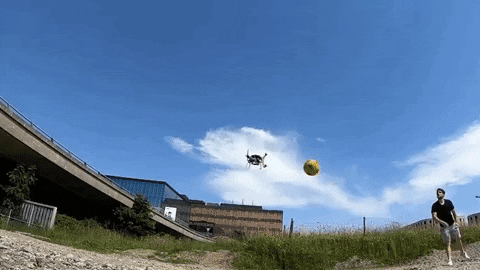This Smart Drone Avoids Things You Throw At It 10 Times Faster Than Other Drones
Dhir Acharya - Mar 28, 2020

A drone should be able to dodge coming obstacles on its own to boost speed and efficiency. And a group of scientists has given it that ability.
- Hundreds Of Drones Crashed Into Building During Performance
- This AI Defense System Forces Drones To Land Autonomously
- IIT Kharagpur Develops Drones To Bring 5G To Zero Network Area
If you think that you can throw a rock to take down a drone, think again because they are not only getting smarter but also getting better at dodging your attacks. In particular, groups of researchers have successfully upgraded a drone by giving it a camera that can spot incoming obstacles quickly. This means the drone will be able to dodge them at 3.5 milliseconds of reaction times.

Even if there’s a human controlling the drone, it will be really useful when the drone can quickly dodge attacks on its own as they fly because the controller may not see an incoming obstacle or respond fast enough. Then, these systems are vitally important for autonomous drones no matter if it’s used for reconnaissance or commercial use.
Currently, the cameras and technologies for processing images used on autonomous drones allow them to react to coming obstacles within 20 to 40 milliseconds, the researchers said. That reaction time is fast, but considering the drone’s speed, which can go up to 240 km/h, many obstacles can be a tactic object, like a flying bird or another drone. In those cases, even 20 milliseconds are not fast enough.

For improving reaction times, the research group attached an event camera to the drone. A normal camera uses a sensor that exposes all the pixel elements simultaneously before sending them for processing, objects can be detected by algorithms only once an entire frame has been analyzed, which delays the reaction. However, the pixels on an event camera are individually smart, they only pass data for processing when there’s a change in what they are seeing. If the pixels don’t see anything new, they will not act, which allows processors and algorithms to focus on just the pixels that have detected a coming obstacle. This helps speed up the whole process.
The researchers developed the custom algorithms of their own, which can recognize threats spotted by the event camera after they sampled footage from a very short time. They also took into account the direction and speed of the drone. As a result, they were able to shorten the reaction time to 3.5 milliseconds, making the drone dodge a coming obstacle much better.
However, there’s space for further improvements. Their testing showed that a drone with the new system could avoid a ball thrown from 3 meters away at around 35 km/h in over 90% of the time. Knowing the size of the obstacle helped the drone perform better, and the event cameras attached to the drone can help it calculate the size of the threat itself. The system can’t help a drone dodge a bullet, for now, but it will certainly help drones fly ten times faster than now. This means drones are becoming more helpful and more dangerous at the same time.
>>> Are You A Drone Hobbyist? Here's Drone Camera Price In India
Featured Stories

Features - Jul 01, 2025
What Are The Fastest Passenger Vehicles Ever Created?

Features - Jun 25, 2025
Japan Hydrogen Breakthrough: Scientists Crack the Clean Energy Code with...

ICT News - Jun 25, 2025
AI Intimidation Tactics: CEOs Turn Flawed Technology Into Employee Fear Machine

Review - Jun 25, 2025
Windows 11 Problems: Is Microsoft's "Best" OS Actually Getting Worse?

Features - Jun 22, 2025
Telegram Founder Pavel Durov Plans to Split $14 Billion Fortune Among 106 Children

ICT News - Jun 22, 2025
Neuralink Telepathy Chip Enables Quadriplegic Rob Greiner to Control Games with...

Features - Jun 21, 2025
This Over $100 Bottle Has Nothing But Fresh Air Inside

Features - Jun 18, 2025
Best Mobile VPN Apps for Gaming 2025: Complete Guide

Features - Jun 18, 2025
A Math Formula Tells Us How Long Everything Will Live

Features - Jun 16, 2025
Comments
Sort by Newest | Popular